|
|
 |
|
Cyclopoida ( Order ) |
|
|
|
Oithonidae ( Family ) |
|
|
|
Oithona ( Genus ) |
|
|
| |
Oithona setigera (Dana, 1849) (F,M) | |
| | | | | | | Syn.: | Scribella setiger Dana, 1849;
Oithona setiger Dana, 1852; T. Scott, 1902 (p.454, Rem.); Wilson, 1942 a (p.196);
O. spinirostris Claus, 1863 (p.105, figs.F); Wilson, 1932 a (p.312, figs.F,M); Wilson, 1942 a (p.197); Lysholm & al., 1945 (p.42, Rem.); Sewell, 1947 (p.255: Rem.); Rae & Rees, 1947 (p.112); C.B. Wilson, 1950 (? part., p.271); ? Carvalho,1952 a (p.166, figs.F); Østvedt, 1955 (p.15: Table 3, p.17, 78); Deevey, 1960 (tab.II); ? Fagetti, 1962 (p.39); Kasturirangan, 1963 (p.75, 77); Shih & al., 1971 (p.56, Rem., 156, 215); Peterson & Miller, 1975 (p.642, 650, Table 3, interannual abundance); 1976 (p.14, Table 1, 2, 3, abundance vs interannual variations); ? Palet, 1975 (p.660); Nishida & al., 1977 (p.126, 128, Rem); Gardner & Szabo, 1982 (p.110, figs.F,M); Mackas & Sefton, 1982 (p.1173, Table 1); ? Huntley & al., 1983 (p.143, Table 2, 3); Mackas & Anderson, 1986 (p.115, Table 2); Landry & Fagerness, 1988 (p.509, Table 1, 3, 5, 6, figs.1, 4, 5, 7, 9, grazing vs behaviour & morphology); Ohman, 1990 (p.257, fig.); Landry & al., 1994 (p.55, abundance, grazing); ? B.W. Hansen & al., 1999 (p.233, seasonal abundance & biomass); Peterson & al., 2002 (p.381, Table 2, interannual abundance); ? Gislason & Astthorsson, 2004 (p.472, tab.1); ? Lavaniegos & Jiménez-Pérez, 2006 (p.149, tab.2, Rem.); Hooff & Peterson, 2006 (p.2610); ? Morales-Ramirez & Suarez-Morales, 2008 (p.522); ? Fernandes, 2008 (p.465, Tabl.2); Tutasi & al., 2011 (p.791, Table 2, abundance distribution vs La Niña event); ? Sigurdardottir, 2012 (p.1, Table 2.3); ? Jagadeesan & al., 2013 (p.27, Table 3, seasonal variation);
O. challengerii Brady, 1883 (p.97, figs.F); T. Scott, 1894 b (p.89); Krishnaswamy, 1953 (p.64, figs.F);
O. tropica Wolfenden, 1905 (1906) (p.1023);
O. pelagica Farran, 1908 a (p.501); 1920 (p.17) | | | | Ref.: | | | Giesbrecht, 1892 (p.538, 548, 774, figs.F); T. Scott, 1894 b (p.91); Thompson & Scott, 1903 (p.236, 255); Farran, 1913 a (p.182, Rem.); Rosendorn, 1917 (p.303); 1917 a (p.20, figs.F,M); Pesta, 1920 (p.554); Farran, 1926 (p.295); 1929 (p.210, 282); Kiefer, 1929 g (p.6, Rem.F,M); Dakin & Colefax, 1933 (p.208); Rose, 1933 a (p.284, figs.F); Farran, 1936 a (p.124); Mori, 1937 (1964) (p.110, figs.F); Sewell, 1947 (p.257, Rem.); Moore, 1949 (p.64, Rem.); Carvalho, 1952 a (p.167, figs.F); Lindberg, 1955 a (p.464: Rem.); Chiba & al., 1957 (p.310); 1957 a (p.12); Marques, 1958 a (p.134); Crisafi, 1959 b (p.59, figs.F,M); Owre & Foyo, 1967 (p.108, figs.F); Vilela, 1968 (p.30); Corral Estrada, 1970 (p.211, Rem.F); Wellershaus, 1970 (p.478, 482); Kos, 1972 (Vol.I, figs.F, Rem.); Razouls, 1972 (p.95, Annexe: p.108, figs.F); Chen & al., 1974 (p.37, figs.F); Nishida & al., 1977 (p.147, figs.F, Rem.: 2 forms); Shuvalov, 1980 (p.109, figs.F,M); Ferrari & Bowman, 1980 (p.19, figs.F); Björnberg & al., 1981 (p.663, figs.F,M); Marques, 1982 (p.770); Zheng & al., 1982 [p.97, Figs.F); Sazhina, 1982 (p.1157, 1160, Rem., fig.N); 1985 (p.90, figs.N); Nishida, 1985 a (p.82, 85, figs.F, Rem.F, p.130); 1986 (p.386); Huys & Boxshall, 1991 (p.229, 442, 465, figs.F); Yoo & Lim, 1993 (p.91, 96, 97, Table 1, fig.2); Kim & al., 1993 (p.271); Chihara & Murano, 1997 (p.939, Pl.196: F); Bradford-Grieve & al., 1999 (p.886, 966, figs.F); Conway & al., 2003 (p.203, figs.F,M, Rem.); Brugnanno & al., 2009 (p.354, Rem.); Avancini & al., 2006 (p.125, Pl. 93, figs.F, Rem.); Vives & Shmeleva, 2010 (p.48, 50, 74, figs.F,M, Rem.) |  issued from : F.D. Ferrari & T.E. Bowman in Smiths. Contr. Zool., 1980, 312. [p.19, Fig.11]. Female (from Caibbean area): a, urosomal segments 1-2 (lateral right side); b, urosomal segment 4 (ventral); c, P4. Nota: Prosome/Urosome = 0.9. Knob near genital opening with short, straight, thick spine, denticulate on posterior edge and small spine ventral to it. Urosomal segment 4 ventrally with 2 rows of 5 or 6 hairs, increasing in length laterally. Endopodal segment 2 of P4 both setae modified, thick, curved, with flange on distal 1/3; proximal seta on endopodal segment 3 of P4 straight, with flange on distal 1/2.
|
 Issued from : S. Nishida in Bull. Ocean Res. Inst., Univ. Tokyo, 1985, No 20. [p.83, Fig.46]. As Oithona setigera typical form. Female: a, habitus (dorsal); b, forehead (lateral); c, A2; d, P1; e, P2; f, P3; g, P4. Nota: Proportional lengths of urosome segments and caudal ramus 10:28:16:15:18:14. Nota after Vives & Shmeleva (2010, p.74): Setal formula on outer margin (in first) and inner margin (in second) of exopod segments (from proximal to distal) of P1 to P4: P1: 1, 1, 3; 1, 1, 4. P2: 1, 0, 2; 1, 1, 5 P3: 1, 0, 1; 1, 1, 5. P4: 0, 0, 1; 1, 1, 5.
|
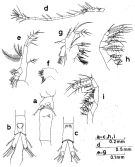 Issued from : S. Nishida in Bull. Ocean Res. Inst., Univ. Tokyo, 1985, No 20. [p.84, Fig.47]. As Oithona setigera typical form. Female: a, thoracic segment 5 and genital segment (lateral left side); b, anal segment and caudal rami (dorsal); c, idem (ventral); d, A1; e, Md (mandibular palp); f, Md (biting edge); g, Mx1; h, Mx2; i, Mxp.
|
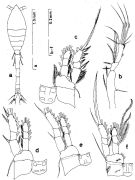 Issued from : S. Nishida in Bull. Ocean Res. Inst., Univ. Tokyo, 1985, No 20. [p.86, Fig.48]. Form with a tapered seta on legs 1-4 basal segment 2. Female: a, habitus (dorsal); b, A2; c, P1; d, P2; e, P3; f, P4.
|
 Issued from : S. Nishida in Bull. Ocean Res. Inst., Univ. Tokyo, 1985, No 20. [p.87, Fig.49]. Form with a tapered seta on legs 1-4 basal segment 2. Female: a, forehead (lateral); b, thoracic segment 5 and genital segment (lateral left side); c, anal segment and caudal rami (dorsal); d, idem (ventral); e, A1; f, Md (mandibular palp); g, Mx1; h, Mx2; i, Mxp.
|
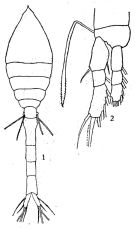 issued from : Q.-c Chen & S.-z. Zhang & C.-s. Zhu in Studia Marina Sinica, 1974, 9. [Pl.5, Figs.1-2]. Female (from China Seas): 1, habitus (dorsal); 2, P3.
|
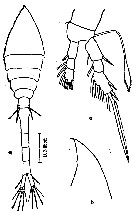 issued from : Z. Zheng, S. Li, S.J. Li & B. Chen in Marine planktonic copepods in Chinese waters. Shanghai Sc. Techn. Press, 1982 [p.98, Fig.57]. Female: a, habitus (dorsal); b, forehead (lateral); c, P2. Scale bar in mm.
|
 issued from : I. Rosendorn in Wiss. Ergebn. dt. Tiefsee-Exped. \\\"Valdiviella\\\", 1917, 23. [p.21, Fig.10]. Female: a, Md (mandibular palp); b, P1; c, P2. Nota: Proportion of lengths (p.cent) Prosome : 66.0, Urosome : 34.0 . Relative lengths of urosomal segments and caudal rami: 8: 19 : 9 : 8 : 11 : 7. Setal formula of the exopod swimming legs P1 to P4 (Se = outer setae ; Si = inner setae), P1 : 1, 1, 3 Se ; 1, 1, 4 Si ; P2 : 1, 0, 2 Se ; 1, 1, 5 Si ; P3 : 1, 0, 1 Se ; 0, 1, 5 Si ; P4 : 0, 0, 1 Se ; 1, 1, 5 Si .
|
 issued from : I. Rosendorn in Wiss. Ergebn. dt. Tiefsee-Exped. \\\"Valdiviella\\\", 1917, 23. [p.22, Fig.11]. Male: a, habitus (dorsal); b, urosome; c, forehead (lateral); d, Md (mandibular palp); e, P1; f, P2; g, P3; h, P4. Nota: Proportion of lengths (p.cent) Prosome : 56.7, Urosome : 43.3 . Relative lengths of urosomal segments and caudal rami: 10: 17: 15: 11: 8.5: 10: 10. Setal formula of the exopod swimming legs P1 to P4 (Se = outer setae ; Si = inner setae), P1 : 1, 1, 3 Se ; 0, 1, 4 Si ; P2 : 1, 1, 3 Se ; 0, 1, 5 Si ; P3 : 1, 1, 3 Se ; 0, 1, 5 Si ; P4 : 1, 1, 2 Se ; 0, 1, 5 Si.
|
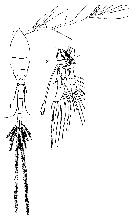 issued from : T. Mori in The Pelagic copepoda from the neighbouring waters of Japan, 1937 (1964). [Pl. 60, Figs.1-2]. Female: 1, habitus (dorsal); 2, P3.
|
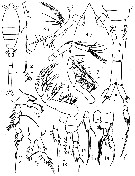 issued from : V.S. Shuvalov in Opred. Faune SSSR, Nauka, Leningrad, 1980, 125. [p.110, Fig.22]. Female: 1, habitus (dorsal); 2, A1; 3, Md (palp); 4, forehead (dorsal); 5, thoracic segments 4 and 5 (dorsal); 6, anal segment and caudal rami (dorsal); 7, Mx2; 8, Mxp; 9, A2; 10, P1; 11, P1 (3rd distal segment of exopod); 12, P2; 13, P2 (3rd exopod segment); 14, P3; 15, P3 (3rd distal segment of exopod); 16, P4; 17, 3rd distal segment of exopod).
|
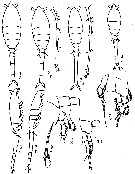 issued from : V.S. Shuvalov in Opred. Faune SSSR, Nauka, Leningrad, 1980, 125. [p.111, Fig.23]. Female: 1-4, habitus (dorsal); 5-6, habitus (lateral); 7, P1 (with exopod at left); 8, P2; 9, P2 (3rd distal segment of exopod); 10, P3. Nota: 1-3, 5-6: from Atlantic ocean; 4, 7-10 from Pacific ocean.
|
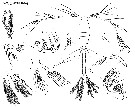 Issued from : G.S. Brady in Rep. Scient. Results Voy. Challenger, Zool., 1883, 8 (23). [Pl. XL, Figs.1-10]. As Oithona challengerii. Female: 1, habitus (dorsal); 2, rostrum; 3, A2; 4, Mx1; 5, Mx2; 6, Mxp; 7, P1; 8, P4; 9-10, basal portions of the two setae of P5.
|
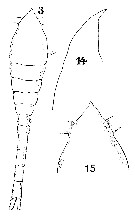 Issued from : W. Giesbrecht in Systematik und Faunistik der Pelagischen Copepoden des Golfes von Neapel und der angrenzenden Meeres-Abschnitte. - Fauna Flora Golf. Neapel, 1892, 19 , Atlas von 54 Tafeln. [Taf. 34, Figs.3, 14, 15]. Female: 3, habitus (dorsal); 14-15, forehead (lateral and dorsal, respectively). Ce = cephalosome.
|
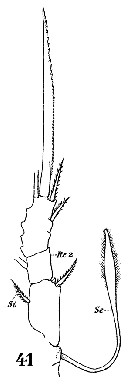 Issued from : W. Giesbrecht in Systematik und Faunistik der Pelagischen Copepoden des Golfes von Neapel und der angrenzenden Meeres-Abschnitte. - Fauna Flora Golf. Neapel, 1892, 19 , Atlas von 54 Tafeln. [Taf. 34, Fig.41]. Female: 41, exopodite of P2. Se = outer seta; Si = inner seta; Re 2 = exopodal segment 2.
|
 issued from : C. Razouls in Th. Doc. Etat Fac. Sc. Paris VI, 1972, Annexe. [Fig.64]. Female (from Banyuls, G. of Lion): A, P4; C-D, forehead (lateral); E, P1; F, P3; G, P2.
|
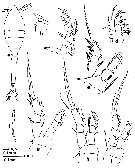 Issued from : S. Nishida, O. Tanaka & M. Omori in Bull. Plankton Soc. Japan, 1977, 24 (2). [p.147, Fig.19]. As Oithona setigera forma typica. Female (from Suruga Bay and adjacent waters): a, habitus (dorsal); b, forehead (lateral); c, Md; d, Mx1; e, P1; f, outer marginal seta on 2nd basal segment of P1; g, P2; h, P3; i, P4. Nota: Setae formula of exopod P1 to P4 (outer setae in first, inner setae in second). P1: 1,1,3; 1,1,4. P2: 1,02; 1,1,5. P3: 1,0,1; 1,1,5. P4: 0,0,1; 1,1,5. Prosome length/urosome length = 1.05-1.09.
|
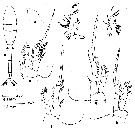 Issued from : S. Nishida, O. Tanaka & M. Omori in Bull. Plankton Soc. Japan, 1977, 24 (2). [p.148, Fig.20]. As Oithona setigera forma pelagicaFemale (from Suruga Bay and adjacent waters): a, habitus (dorsal), b, forehead (lateral); c, Md; d, Mx1; e, P1; f, P2; g, P3; h, P4. Prosome length/urosome length = 0.93-1.17.
|
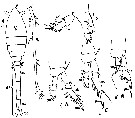 Issued from : M.C. Kos in Field guide for plankton. Zool Institute USSR Acad., Vol. I, 1972. . After B.S. Shuvalov. (original). Female: 1, habitus (dorsal); 2, A1; 3, P1; 4, P2; 5, P3; 6, P4.
|
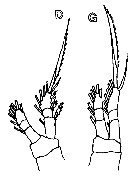 Issued from : K.-I. Yoo & D.-H. Lim in The Korean J. Syst. Zool., 1993, 9 (2) [p.99, Fig.2, D, G] Female (from East and South Korean Waters): D, P1; G, P4 (Note the curved outer margin spine on the 3rd exopodal segment)..
| | | | | Compl. Ref.: | | | Carl, 1907 (p.17); Yamazi, 1958 (p.153, Rem.); Fagetti, 1962 (p.39); Grice & Hart, 1962 (p.287, table 4: abundance); Ganapati & Shanthakumari, 1962 (p.10, 16); Duran, 1963 (p.25); Giron-Reguer, 1963 (p.56); V.N. Greze, 1963 a (tabl.2); Shmeleva, 1963 (p.141); Grice, 1963 a (p.496); Gaudy, 1963 (p.30, Rem.); Björnberg, 1963 (p.76, Rem.); Neto & Paiva, 1966 (p.29, Table III); De Decker & Mombeck, 1964 (p.13); Shmeleva, 1965 b (p.1350, lengths-volume -weight relation); Furuhashi, 1966 a (p.295, vertical distribution vs mixing Oyashio/Kuroshio region, Table 9); Mazza, 1966 (p.73); Pavlova, 1966 (p.44); Ehrhardt, 1967 (p.742, geographic distribution, Rem.); Séguin, 1968 (p.488); Delalo, 1968 (p.138); Deevey, 1971 (p.224); Binet & al., 1972 (p.68); Bainbridge, 1972 (p.61, Appendix Table I: vertical distribution vs day/night, Table II: %); Apostolopoulou, 1972 (p.329, 373); Björnberg, 1973 (p.388); Corral Estrada & Pereiro Muñoz, 1974 (tab.I); Vives & al., 1975 (p.53, tab.II, III); Zalkina, 1977 (p.339, tab.1); Klekowski & al., 1977 (p.467, respiration); Boxshall, 1977 b (p.552); Deevey & Brooks, 1977 (p.156, tab.2, Station "S"); Dessier, 1979 (p.207); Vaissière & Séguin, 1980 (p.23, tab.2); Rudyakov, 1982 (p.208, Table 2); Vives, 1982 (p.295); Kovalev & Shmeleva, 1982 (p.85); Scotto di Carlo & Ianora, 1983 (p.150); Scotto di Carlo & al., 1984 (p.1041); Tremblay & Anderson, 1984 (p.7, Rem.); Guangshan & Honglin, 1984 (p.118, tab.); Sazhina, 1985 a (p.491, tab.3); Renon, 1987 (tab.2); Cervantes-Duarte & Hernandez-Trujillo, 1989 (tab.3); Hirakawa & al., 1990 (tab.3); Scotto di Carlo & al., 1991 (p.270); Yoo, 1991 (tab.1); Seguin & al., 1993 (p.23); Shih & Young, 1995 (p.75); Webber & Roff, 1995 (tab.1); Suarez-Morales & Gasca, 1997 (p.1525); Park & Choi, 1997 (Appendix); Noda & al., 1998 (p.55, Table 3, occurrence); Hure & Krsinic, 1998 (p.77, 103, 112); McKinnon & Klumpp, 1998 (tab.1); Alvarez-Cadena & al., 1998 (t.1,2,3,4); Hsieh & Chiu, 1998 (tab.2); Suarez-Morales, 1998 (p.345, Table 1); Suarez-Morales & Gasca, 1998 a (p.112); Siokou-Frangou, 1999 (p.478); Lopes & al., 1999 (p.215, tab.1); Neumann-Leitao & al., 1999 (p.153, tab.2); Lavaniegos & Gonzalez-Navarro, 1999 (p.239, Appx.1); El-Sherif & Aboul Ezz, 2000 (p.61, Table 3: occurrence); Ueda al., 2000 (tab.1); Suarez-Morales & Gasca, 2000 (1247, tab.1); Suarez-Morales & al., 2000 (p.751, tab.1); Seridji & Hafferssas, 2000 (tab.1); Lopez-Salgado & al., 2000 (tab.1); Holmes & Gotto, 2000 (p.3, Rem.); Lapernat & Razouls, 2001 (tab.1); Lo & al., 2001 (1139, tab.I); Zerouali & Melhaoui, 2002 (p.91, Tableau I); Hwang & al., 2003 (p.193, tab.2); Vukanic, 2003 (p.139, tab.1); Daly Yahia & al., 2004 (p.366, fig.4); Lan & al., 2004 (p.332, tab.1, tab.2); Lo & al.*, 2004 (p.218, fig.6); Lo & al., 2004 (p.89, tab.1); Vukanic & Vukanic, 2004 (p.9, tab. 2, 3); Mazzocchi & al., 2005 (p.155); Lakkis & al., 2005 (p.152); Camisotti & al., 2005 (p.99); Hwang & al., 2005 (p.106); Prusova & Smith, 2005 (p.76); Isari & al., 2006 (p.241, tab.II); Hwang & al., 2006 (p.943, tabl. I); Sterza & Fernades, 2006 (p.95, Table 1, occurence); Dias & Araujo, 2006 (p.72, Rem., chart); Zervoudaki & al., 2006 (p.149, Table I); Khelifi-Touhami & al., 2007 (p.327, Table 1); Hwang & al., 2007 (p.25); Neumann-Leitao & al., 2008 (p.799: Tab.II, fig.6); McKinnon & al., 2008 (p.843: Tab.1, p.848: Tab. IV); Ayon & al., 2008 (p.238, Table 4: Peruvian samples); Lopez Ibarra, 2008 (p.1, Table 1, fig.11: abundance); Morales-Ramirez & Suarez-Morales, 2008 (p.522); Fernandes, 2008 (p.465, Tabl.2); Gaard & al., 2008 (p.59, Table1, N Atlantic Mid-Ridge); Rossi, 2008 (p.90: Tableau XII); Tseng L.-C. & al., 2008 (p.153, fig.5, Table 2, occurrence vs geographic distribution, indicator species); Lan Y.-C. & al., 2008 (p.61, Table 1, % vs stations); Pagano, 2009 (p.116); C.-Y. Lee & al., 2009 (p.151, Tab.2); Galbraith, 2009 (pers. comm.); Chiba & al., 2009 (p.1846, Table 1, occurrence vs temperature change); Tseng & al., 2009 (p.327, fig.5, feeding); Licandro & Icardi, 2009 (p.17, Table 4); Lan & al., 2009 (p.1, Table 2); C.E. Morales & al., 2010 (p.158, Table 1); Hwang & al., 2010 (p.220, Table 2, fig.3, 4); Hafferssas & Seridji, 2010 (p.353, Table 3); Williamson & McGowan, 2010 (p.273, Table 3, Pacific central gyres: N and S); Hernandez-Trujillo & al., 2010 (p.913, Table 2); Hidalgo & al., 2010 (p.2089, fig.4, Table 2, cluster analysis); Dias & al., 2010 (p.230, Table 1); Mazzocchi & Di Capua, 2010 (p.428); Medellin-Mora & Navas S., 2010 (p.265, Tab. 2); Hsiao S.H. & al., 2011 (p.475, Appendix I); Hsiao & al., 2011 (p.317, Table 2, indicator of seasonal change); Kâ & Hwang, 2011 (p.155, Table 3: occurrence %); Mazzocchi & al., 2011 (p.1163, fig.6, long-term time-series 1984-2006); Isari & al., 2011 (p.51, Table 2, abundance vs distribution); Andersen N.G. & al., 2011 (p.71, Fig.3: abundance); Mazzocchi & al., 2012 (p.135, annual abundance 1984-2006); Uysal & Shmeleva, 2012 (p.909, Table I); Salah S. & al., 2012 (p.155, Tableau 1); Miloslavic & al., 2012 (p.165, Table 2, transect distribution); Brugnano & al., 2012 (p.207, Table 2); Tseng & al., 2012 (p.621, Table 3: abundance); Jean & al., 2012 (p.12, Table 3, protein vs environmental metal stress); Almeida LR. & al., 2012 (p.13, Table 1, abundance); Hidalgo & al., 2012 (p.134, Table 2, 3, figs. 5, 6, spatial distribution vs hydrology); Zamora-Terol & Saiz, 2013 (p.376, Rem.: Table 3, egg production); Palomares-Garcia & al., 2013 (p.1009, Table I, abundance vs environmental factors); in CalCOFI regional list (MDO, Nov. 2013; M. Ohman, comm. pers.); Tachibana & al., 2013 (p.545, Table 1, seasonal change 2006-2008); Tseng & al., 2013 (p.507, seasonal abundance); Mendoza Portillo, 2013 (p.37: Fig.7, seasonal dominance); Terbiyik Kurt & Polat, 2013 (p.1163, Table 2, seasonal distribution); Siokou & al., 2013 (p.1313, fig.4, 8, biomass, vertical distribution); Lidvanov & al., 2013 (p.290, Table 2, % composition); Hwang & al., 2014 (p.43, Appendix A: seasonal abundance); Bonecker & a., 2014 (p.445, Table II: frequency, horizontal & vertical distributions); Lopez-Ibarra & al., 2014 (p.453, fig.6, biogeographical affinity); Mazzocchi & al., 2014 (p.64, Table 3: occurrence); Pino-Pinuer & al., 2014 (p.83, Table 1, fig.3, abundance variation vs time); Fierro Gonzalvez, 2014 (p.1, Tab. 3, 4, 5, occurrence, abundance); Dias & al., 2015 (p.483, Table 2, abundance, biomass, production); Zakaria & al., 2016 (p.1, Table 1); Benedetti & al., 2016 (p.159, Table I, fig.1, functional characters); Marques-Rojas & Zoppi de Roa, 2017 (p.495, Table 1); Bonecker C.T. & al., 2017 (p.247, fig.8: abundance day/night vs. vertical types of mass water); El Arraj & al., 2017 (p.272, table 2); Benedetti & al., 2018 (p.1, Fig.2: ecological functional group); Dias & al., 2018 (p.1, Table 5: % vs. season); Hure M. & al., 2018 (p.1, Table 1: abundance, % composition); Palomares-Garcia & al., 2018 (p.178, Table 1: occurrence); Acha & al., 2020 (p.1, Table 3: occurrence % vs ecoregions). | | | | NZ: | 18 | | |
|
Distribution map of Oithona setigera by geographical zones
|
| | | | | | | | | | | |  Issued from : S. Nishida in Bull. Ocean Res. Inst., Univ. Tokyo, 1985, No 20. [p.130, Fig.79]. Issued from : S. Nishida in Bull. Ocean Res. Inst., Univ. Tokyo, 1985, No 20. [p.130, Fig.79].
Indo-Pacific geographical distribution of Oithona setigera. Dotted line: AC, Arctic Convergence; SC, Subtropical Convergence. |
 issued from : A.A. Shmeleva in Bull. Inst. Oceanogr., Monaco, 1965, 65 (n°1351). [Table 6: 38]. Oithona setigera (from South Adriatic). issued from : A.A. Shmeleva in Bull. Inst. Oceanogr., Monaco, 1965, 65 (n°1351). [Table 6: 38]. Oithona setigera (from South Adriatic).
Dimensions, volume and Weight wet. Means for 50-60 specimens. Volume and weight calculated by geometrical method. Assumed that the specific gravity of the Copepod body is equal to 1, then the volume will correspond to the weight. |
 Issued from K.-I. & D.-H. Lim in The Korean J. Syst. Zool., 1993, 9 (2). [Key of female]: ]Morphological characters of Oithona setigera female in Korean waters : Issued from K.-I. & D.-H. Lim in The Korean J. Syst. Zool., 1993, 9 (2). [Key of female]: ]Morphological characters of Oithona setigera female in Korean waters :
1 - Anterior part of prosome produced into pointed rostrum in dorsal view.
2 - Exopod 3rd segment of P1 with 3 outer marginal spines.
3 - Exopod 3rd segment of P4 with 1 spine. |
 Issued from : A.C.T. Bonecker, A. V. de Araujo, C.O. Dias, M.M.S. Castro, P.F. Carvalho, R.M. Lopes & S.C.L. Bonecker in A.P.C. Falcao & D.L. Moreira (ed.) Ambiente pelagico caracterizaçao ambiental regional de Bacia de Campos, Atlantico Sudoeste. Rio de Janeiro. Elsevier. 2017, v.5, p.247-281. [p.260, Fig.8] Issued from : A.C.T. Bonecker, A. V. de Araujo, C.O. Dias, M.M.S. Castro, P.F. Carvalho, R.M. Lopes & S.C.L. Bonecker in A.P.C. Falcao & D.L. Moreira (ed.) Ambiente pelagico caracterizaçao ambiental regional de Bacia de Campos, Atlantico Sudoeste. Rio de Janeiro. Elsevier. 2017, v.5, p.247-281. [p.260, Fig.8]
Abundance (ind. m-3) sampled during night and day into four water masses in the Campos Basin (Brazil).
AT: Tropical water; ACAS: Central water of South Atlantic; AIA: Intermediate water of Antarctica; ACS: Deep water Circumpolar water superior.
Sampling at station c (22°54'30''S, 40°43'W), depth 1900 m (end of the continental slope). |
 Issued from : S. Zamora Terol in Tesis Doc. Univ. Politèc. Catalunya, 2013 [p.82-83, Table 3]. Issued from : S. Zamora Terol in Tesis Doc. Univ. Politèc. Catalunya, 2013 [p.82-83, Table 3].
Comparison of egg production and clutch sizes among different species of Oithona from field and lab studies.
a: body total length.
Also, see: Oithona attenuata, O. colcarva, O. davisae, O. nana, O. plumifera, O. aruensis, O. similis, O. simplex. |
 Issued from : C. Castellani, C. Robinson, T. Smith & R.S. Lanpitt in mar. Ecol/ Progr. Ser., 2005, 285. [p.132, Table 1]. Issued from : C. Castellani, C. Robinson, T. Smith & R.S. Lanpitt in mar. Ecol/ Progr. Ser., 2005, 285. [p.132, Table 1].
Oithona spp. Summary of respiration rates (range) reported in the litterature in different regions.
b: converted to carbon from dry weight assuming body carbon as 40% of dry weight (Mauchline, 1998); c: converted to dry weight from wet weight assuming 81% water content (Mauchline, 1998); d: measurements made during 17 of RV 'Academic Kurchatov' between 05°21' N, 88°05' W and 00°01' S, 139°41' W.
Cf. Oithona similis to compare to other species in Table 1 in the same authors. |
 Issued from : M.R. Landry & V.L. Fagerness in Bull. Mar. Sc., 1988, 43 (3) [p.512, Fig.2]. Issued from : M.R. Landry & V.L. Fagerness in Bull. Mar. Sc., 1988, 43 (3) [p.512, Fig.2].
Clearance rates of Oithona spinirostris (= Oithona setigeraData from Landry (unpubl.). |
 Issued from : M.R. Landry & V.L. Fagerness in Bull. Mar. Sc., 1988, 43 (3) [p.514, Table 3]. Issued from : M.R. Landry & V.L. Fagerness in Bull. Mar. Sc., 1988, 43 (3) [p.514, Table 3].
Comparison of size of body and appendages for seven species of marine copepods. Relationships among predation rates, selection patterns, swimming speed and orientation, and morphology of prey sensory and capture appendages.
Nota: Oithona spinirostris = Oithona setigera. |
 Issued from : M.R. Landry & V.L. Fagerness in Bull. Mar. Sc., 1988, 43 (3) [p.520, Fig. 9]. Issued from : M.R. Landry & V.L. Fagerness in Bull. Mar. Sc., 1988, 43 (3) [p.520, Fig. 9].
Swimming speeds and directions of the copepods Tortanus discaudatus, Corycaeus anglicus, Oithona spinifera (= Oithona setigera). See also to Neocalanus cristatus, Euchaeta elongata (= Paraeuchaeta elongata), Calanus pacificus.
Swimming speeds measured as displacement over 2-s time intervals. 0° is up.
Study of the relationships among predation rates, selection patterns, swimming speed and orientation, and morphology of prey sensory and capture appendages.
The mean relative swimming speeds (S) of the predatory copepods and their preferred prey were calculated by the equation (Gerritsen, 1980).
S = [u + v)3 - [u - v)3 / 6uv.
u and v are respectively, the mean swimming speeds (mm/s) of the prey and the predator. |
 Issued from : M.R. Landry & V.L. Fagerness in Bull. Mar. Sc., 1988, 43 (3) [p.522-523, Table 5]. Issued from : M.R. Landry & V.L. Fagerness in Bull. Mar. Sc., 1988, 43 (3) [p.522-523, Table 5].
Comparison of the predatory characteristics of seven planktonic marine copepods. Oithona spinirostris = Oithona setigera.
F max is the mean, maximum clearance rate measured for the predator feeding on its preferred prey. Prey are developmental stages of common species of planktonic copepods.
F = female, M = male, C5 = stage 5. |
| | | | Loc: | | | South Africa (E), Angola, Baia Farta, Congo, G. of Guinea, Ivorian shelf, off Cape Verde Is., Canary Is., off Morocco-Mauritania, Cap Ghir, off Madeira, Brazil (S, off Macaé, off Rio de Janeiro, Cabo Frio, Campos Basin, Vitoria Bay, Vitoria-Cabo de Sao Tomé, Guarairas Lagoon, off Natal), off Amazon, off Trinidad Is., Barbados Is., Venezuela, Bahia de Mochima, Caribbean Colombia (San Andrés y Providencia, Tayrona), Caribbean Sea, Jamaica, Yucatan, G. of Mexico, Cuba, Sargasso Sea, off Bermuda (Station "S"), Delaware Bay, G. of Maine, Nova Scotia (St. Margaret's Bay), ? W Greenland (Disko Bay), ? Iceland, Shetland Is., Norwegian Sea, Bay of Biscay, W Ireland, North Sea, Ibero-moroccan Bay, Medit. (Alboran Sea, Gulf of Annaba, Castellon, Banyuls, Marseille, Toulon Harbour, Ligurian Sea, Tyrrhenian Sea, G. of Napoli, Strait of Messina, NW Tunisia, off Malta, Adriatic Sea, Ionian Sea, Aegean Sea, Thracian Sea, Iskenderun Bay, W Egyptian coast, Lebanon Basin, Port Said), Sharm El-Sheikh, Taba, Hurgada, Safaga, Red Sea, G. of Aden, Arabian Sea, Maldive Is., Madagascar (Nosy Bé), Rodrigues Is., Indian, India (? Saurashtra coast, Lawson's Bay, Madras, Gulf of Mannar, Palk Bay), Bay of Bengal, Nicobar Is. (Nankaurie Harbour), Indonesia-Malaysia, Ambon Bay (Baie d'Amboine) Sulu Sea, Philippines, China Seas (Yellow Sea, East China Sea, South China Sea, Pa-Li), Taiwan Strait, Taiwan (E, S, SW, NW, N, NE, Mienhua Canyon), E & S Korea, Cheju Is., S Japan Sea, Japan, Kuchinoerabu Is., Tokyo Bay, Tanabe Bay, Kuroshio Current, Bikini Is., Pacif. (W equatorial), Pacific (central gyres: N and S), E & W Australia (Haughton Riv., Great Barrier, off Port Jackson, Shark Bay, North Cape), New Zealand, Pacif. (tropical), Station "P", British Columbia, Fjord system (Alice Arm & Hastings Arm), Portland Inlet, Vancouver Is., Dabob Bay, Oregon (Yaquina, off Newport), Bay of San Francisco, California, W Baja California (Bahia Magdalena), La Paz, G. of California, W Mexico, W Costa Rica, Clipperton Is., SE Pacif., Galapagos-Ecuador, Peru, Chile (N-S, off Santiago, Concepcion) | | | | N: | 249 ? | | | | Lg.: | | | (34) F: 2,04-1,32; (35) [Atlant. trop.] F: 1,85-1,8; [N-Z] F: 1,8-1,25; (38) F: 1,59-1,4; (46) F: 1,6-1,5; (78) F: 1,75; (109) F: 1,6-1,4; (180) F: ; 1,9-1,7; 1,4-1,25; (237) F: 1,8-2,0; M: 0,93; (314) F: 1,93-1,21; M: 1,12; (327) F: 1,51-1,22; (332) F: 1,69; 1,55; M: 0,53; (531) F: 1,4; 1,3; (624) F: 1,69-1,57; (626) F: 1,52-1,36; (627) F: 1,9-1,14; (634) ? F: 1,9-1,6; 1,26-1,2; (649) F: 1,57; M: 0,90; (864) F: 1,1; (866) M: 0,9; (880) F: 1,57; M: 0,9-1,2; (920) F: 1,73; (991) F: 1,12-1,9; M: 0,9; (1023) F: 1,67-1,78; (1259) F: 1,3; (1230) F: 1,08-1,95; M: 0,9-1,2; {F: 1,08-2,04; M: 0,54-1,20}.
(1259) F: 1,3 (total length), 0,68 (prosome length); A1 = 1,0 mm. (total length). | | | | Rem.: | Epi-mesopelagic-bathypelagic. Sargasso Sea: 0-500 m (Deevey & Brooks, 1977, Station "S"). 0-30010 m at Station T-1 (E Tori Is., E middle Japan) from Furuhashi (1966 a).
Nishida (1985, p.85) points to an historical account of this species. Farran found that specimens of the Irish coast differed only from the type from the Pacific in having the setae of the basipodites simple and not clavate. Taking into account the size differences, Farran (1929) suggests the existence of two groups.
Oithona setigera pelagica Nishida, Tanaka & Omori,1977 (F)
Syn.: Oithona pelagica Farran, 1908 a (p.501)
Ref.: Nishida & al., 1977 (p.148, figs.F, Rem.); Lapernat, 1999 (p.29); Vives & Shmeleva, 2010 (p.75, figs.F,M, Rem.).
Lg.: (155) F: 1,9-1,15; (340) F: 1,4-1,3; 0,9
Rem.: (off Malta: 1500-2000 m)
.
Oithona setigera typica Nishida, Tanaka & Omori,1977 (F)
Ref.: Nishida & al., 1977 (p.147, figs.F, Rem.); Nishida, 1985 a (p.82,figs.F); Vives & Shmeleva, 2010 (p.54, figs.F,M, Rem.).
After Benedetti & al. (2018, p.1, Fig.2) this species belonging to the functional group 6 corresponding to small ambush feeding omnovorous.
See in DVP Conway & al., 2003 (version 1) | | | Last update : 25/10/2022 | |
|
|
 Any use of this site for a publication will be mentioned with the following reference : Any use of this site for a publication will be mentioned with the following reference :
Razouls C., Desreumaux N., Kouwenberg J. and de Bovée F., 2005-2026. - Biodiversity of Marine Planktonic Copepods (morphology, geographical distribution and biological data). Sorbonne University, CNRS. Available at http://copepodes.obs-banyuls.fr/en [Accessed January 07, 2026] © copyright 2005-2026 Sorbonne University, CNRS
|
|
 |
 |



























